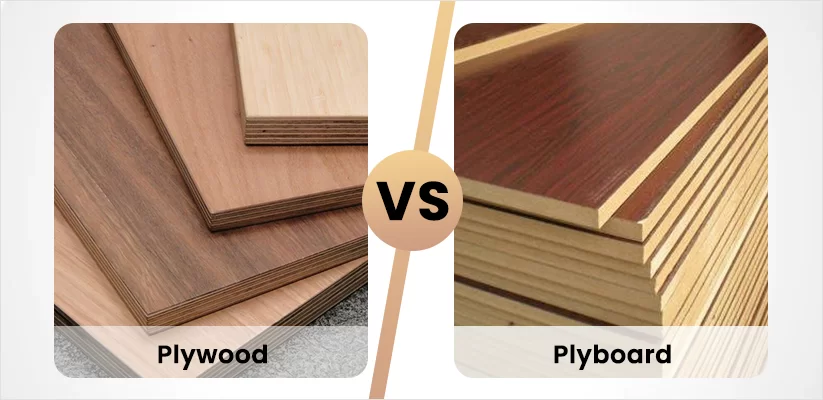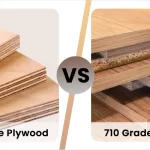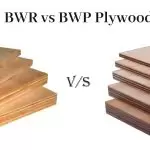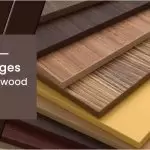Plywood and plyboard are engineered wood products. Both plywood and plyboard are mainly used for making furniture and interior decor elements. The confusion about whether to use plywood or plyboard for a particular purpose often arises in the minds of property owners. Hence, it is beneficial to know about the Difference between Plywood and Plyboard.
Post your Requirement
What is Plywood?
Plywood is a sheet made by stacking wood veneer sheets over one another and glueing them using a resin under high pressure. The wood grain of adjacent layers is rotated up to 90 degrees from one another.
What is Plyboard?
Plyboard consists of softwood strips glued together, which make up its core. The softwood strips are placed edge to edge and covered by hardwood or softwood veneer sheets on both sides. The veneer sheets are bonded to the softwood strips under high temperature and pressure to form a plyboard. The softwood strips are usually 28mm in width.
Suggested Post: What are Veneer Sheets & Its Types
Comparison between plywood and plyboard
The various points regarding Plywood vs Plyboard have been listed here.
- Plywood is resistant to moisture and does not carry much risk of water damage. Plyboard, on the other hand, retains moisture and is more likely to suffer water damage.
- Plywood can sag and bend from the centre. Plyboard, on the other hand, is less susceptible to bending because it is stiffer than plywood.
- Plywood is resistant to warping and cracking. The plyboard is even more resistant to warping and cracking.
- Plyboard is lighter in weight compared to plywood. This is because the core of a plyboard is made of softwood strips, which are light in weight compared to hardwood veneers making up the core of plywood.
- The board edge of a plywood shows layers of wooden sheets glued with one another. The board edge of a plyboard, on the other hand, has a solid wooden appearance.
Related Post: What is a Particle Board & Its Different Types
- Plywood is difficult to cut because it can splinter while being cut. Plyboard, on the other hand, can be cut easily with conventional woodwork tools without the risk of splintering.
- Plywood is uniform throughout its length and breadth. Plyboard, on the other hand, has small gaps between the blocks, which are not visible to the naked eye.
- Plywood exhibits high strength and durability because the wood grains of alternate layers are rotated up to 90 degrees from one another. Plyboard, on the other hand, has less strength than plywood because softwood strips are used to make the core. However, the strength can be increased if hardwood strips are used instead of softwood strips.
- Plywood surface displays the grain characteristics of the wood. The surface can also be painted, veneered, laminated or lacquered. Plyboard, on the other hand, does not display a grain pattern on the surface. Thus, it is available in various surface finishes such as wood veneer, plastic laminates, melamine paper, etc.
Suggested Post: What are Advantages and Disadvantages of MDF Board
- Plywood sheets come in various thicknesses, which range between 3mm and 25mm. Plyboards, on the other hand, are available in thicknesses ranging between 16mm and 25mm. Both are, however, available in the standard size of 8ft X 4ft. Customized sizes are also offered by manufacturers.
- Plywood is used to make furniture for homes and offices. It is also used for making floors, walls, roofs, concrete shuttering panels, kitchen cabinets, fences, external sheathing, boats and ships. However, plywood is not suitable for making long furniture because it is prone to bending from the centre. Plyboard, on the other hand, is used to make wooden products which require long pieces of wood because it is not susceptible to bending, unlike plywood. The various products include bookshelves, benches, tables, wardrobes, wall panels, sliding doors, etc.
- Plywood has a very long life. Veneering or laminating the plywood sheet enhances its life span to up to 50 years or more. Plywood’s life span is also increased in a dry environment. Plyboard, on the other hand, has a lesser life span compared to plywood. However, it has a longer life span compared to other types of engineered wood products.
- Plywood is costlier compared to plyboard because softwood strips are used in the latter, which are cheap.
- When strength is a major consideration, as in kitchen cabinets or flooring, plywood is a good choice. Plyboard can be used for tables, shelves, benches and other long-span wooden products.
Determine Your Needs And Choose The Best Material For You
Both plywood and plyboard are highly versatile wood products that come with their own distinct set of features and characteristics that make them perfect for different applications. The material of plywood ensures superior strength and durability along with moisture resistance, thereby making it ideal for high-load-bearing furniture, flooring, and cabinetry. On the other hand, the plyboard is a lightweight and cost-effective material that comes with a resistance to bending, thereby making it ideal for bookshelves, tables, and other long-span wooden structures. You need to determine your specific needs and requirements, then compare and analyze to choose the best choice for you in terms of durability, cost, and intended use.
FAQ’S
Q:1 Which is more costly, plywood or plyboard?
A:1 Plywood is generally more expensive compared to plywood. This is because plywood is made with high-quality materials like hardwood veneers, thereby ensuring superior strength and durability, while plyboard often uses a cheaper softwood core, making it a more budget-friendly option.
Q:2 Is Plywood waterproof?
A:2 Not all plywood is waterproof, but some are designed with effective water-resistant features that allow the structures to provide superior performance even with continuous exposure to moisture. The high-quality versions, such as BWP (Boiling Water Proof) or Marine Plyboards, are treated to withstand moisture and humidity.
Q:3 Which plywood is the best quality?
A:3 The best type and quality of plywood for you depends on your intended use and the conditions in which the material will be used. You can go for marine plywood (BWP Grade) for a highly durable and waterproof choice, particularly for kitchens, bathrooms, and outdoor use; BWR Plywood (Boiling Water Resistant) for the manufacturing of furniture and areas exposed to moisture; and Gurjan Plywood made from high-quality hardwood, offering high strength and longevity.
Q:4 What is a plyboard used for?
A:4 The material plyboard is used for a wide range of applications such as to build structural support in construction projects like flooring, roofing, wall sheathing, and furniture making, such as tables, chairs, wardrobes, partitions, and paneling in homes and offices, wall cladding for decorative purposes and false ceilings in interior design.























Post A Comment